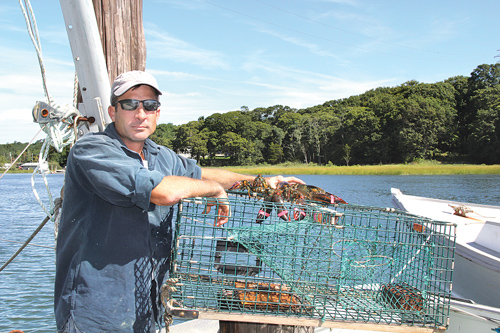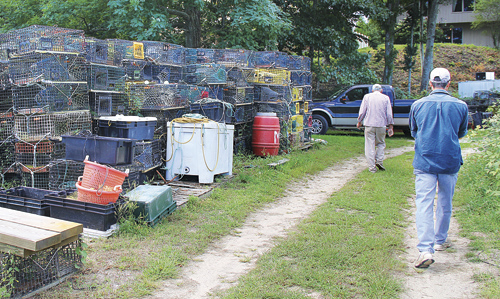Locals reflect on dying industry as sound closes to fall lobster harvesting

A third-generation lobsterman, Matt DeMaula has patrolled Long Island Sound alongside his father and uncles for more than two decades.
When he thinks back to his early days in the profession, the Mattituck native can recall some remarkable fall seasons.
“We used to call them ‘Septembers to remember,’ ” Mr. DeMaula said as he prepared to take the last of his lobster traps out of the Sound Friday. “We’ll never have another one of those.”
On Sunday, the state Department of Environmental Conservation closed Sound waters to lobster harvesting through Nov. 28, following a decision made last February by the Atlantic States Marine Fisheries Commission, which regulates Southern New England area fisheries. The move marks the first time in the fishery’s history that the state is shutting down harvesting in the Sound.
The commission’s goal is to decrease lobster landings by 10 percent annually, helping to rebuild the Sound’s “depleted” lobster population, according to the DEC.
“They should have done it 20 years ago,” said lobsterman and Southold Town Trustee Jimmy King. He has been lobster fishing out of Mattituck Inlet for more than 50 years and is a former president of the Long Island Lobstermen’s Association.

A combination of rising water temperatures, low dissolved oxygen, pesticide runoff and nitrogen loading proved too much for the crustaceans, causing an extreme die-off in 1999, said Emerson Hasbrouck, senior marine environmental issues educator at Cornell Cooperative Extension of Suffolk County.
“[The lobster] simply haven’t recovered since,” Mr. King said.
Both Mr. Hasbrouck and Mr. King said the decline was driven by the environmental impacts rather than pressure from overfishing the Sound.
At the industry’s height in 1996, lobstermen landed 9.4 million pounds of lobster from Sound waters, equaling $32.9 million in revenue, according to state DEC data. That year the state DEC issued 932 resident commercial lobster permits.
By 2012, lobstermen caught just 269,000 pounds from Sound waters, generating $975,000, according to the same data. Only 334 resident commercial lobster permits were issued that year.
“There’s hardly anything being caught in the Sound anymore,” Mr. Hasbrouck said. “Most of the lobstermen have gotten out of it. They’ve either left fishing altogether or they are involved in other fisheries.”
Lobstermen once traveled to Orient from as far as City Island in the Bronx to fish for lobster in the Sound, Mr. Hasbrouck said. A couple of hundred men tended the many lobster boats, each of which was typically fishing about 1,000 pots.
“Today, you simply couldn’t make it as a lobsterman,” Mr. King said.
Only a handful of lobstermen continue the trade locally, including Mr. DeMaula and Phil Karlin, 72, of Riverhead. Each has had to diversify as lobster stocks have dwindled, catching finfish or conch to help make a living.
“I think what we’re afraid of is that once regulations like these come down, the restrictions will never be taken off — no matter how good things get again,” Mr. Karlin said. “I think that scares people. It does scare me in some respects.”
Mr. DeMaula said rather than a full closure of the Sound he would have preferred a management plan regulating the number of traps lobstermen can use, a strategy he says has worked in Maine.
A decade ago, Mr. DeMaula fished using 600 to 700 traps. This year, he said, he used only 125.
“That wasn’t a state-planned restriction, it was a self-imposed reduction,” he said. “The amount of [lobster] I was catching didn’t warrant me putting them all in. That’s a 10 percent reduction achieved without the closure.”
The closure dates, Sept. 8 to Nov. 28, were decided on by lobstermen from New York and Connecticut on the Atlantic States Marine Fisheries Commission’s lobster conservation management team.
It comes “during a time when water temperature is high and stressful to lobster” and “when lobster often experience a secondary molting event,” according to state DEC officials.
Mr. Karlin said the closure would not affect him, as most of his traps are out of Sound waters by early September.
However, Mr. DeMaula said he is losing several weeks of income. He would otherwise be fishing throughout September and would begin fishing again before Thanksgiving.
For him, the fall closure adds to the many regulations that make it difficult to make a living as a fisherman, he said.
“It’s just frustrating for me,” Mr. DeMaula said. “I wasn’t going to be a millionaire, but I got to make an honest living spending time on the water with family.
“None of the young guys want to deal with the regulations,” he said. “It’s a way of life that’s being lost.”








